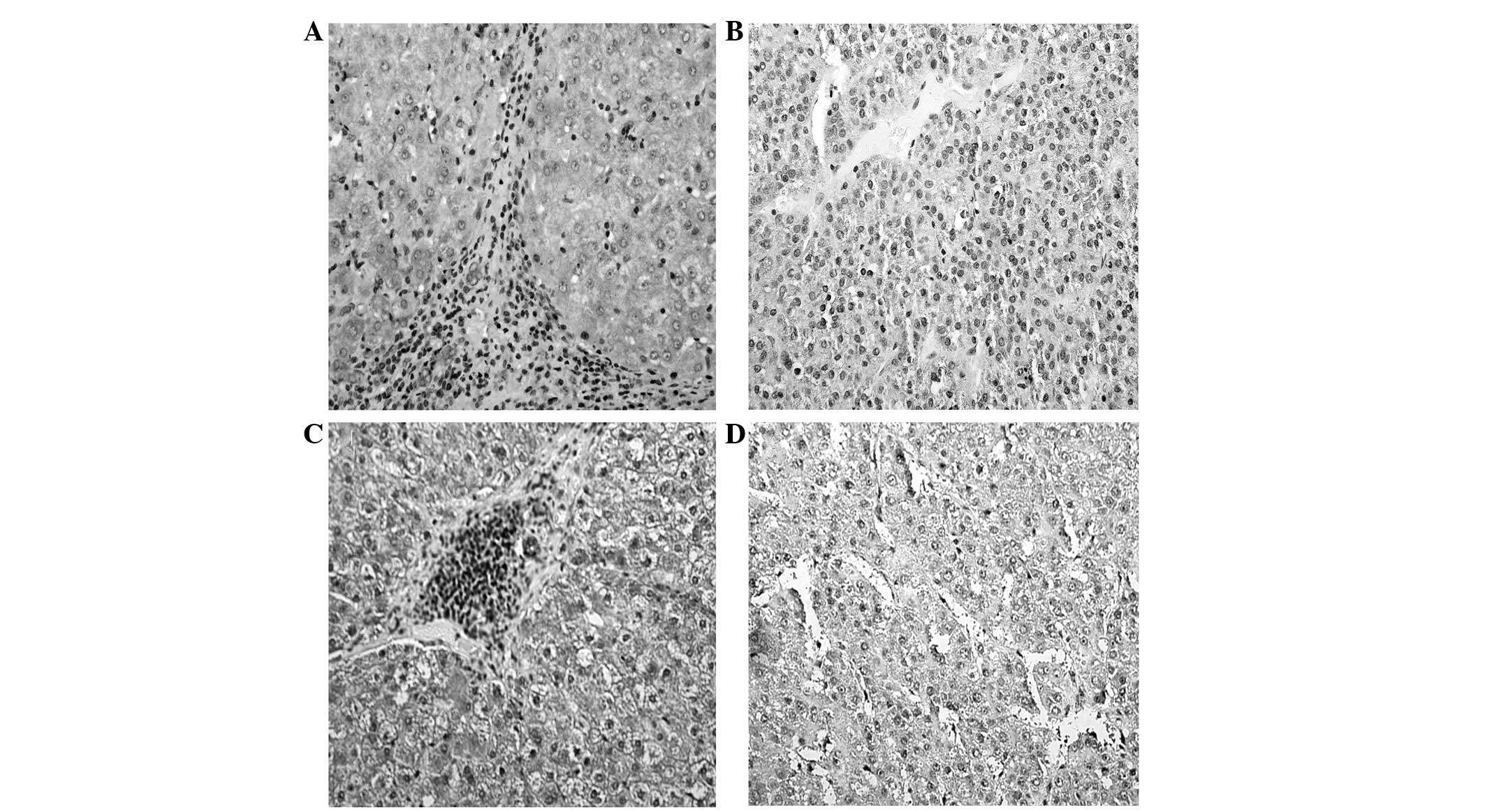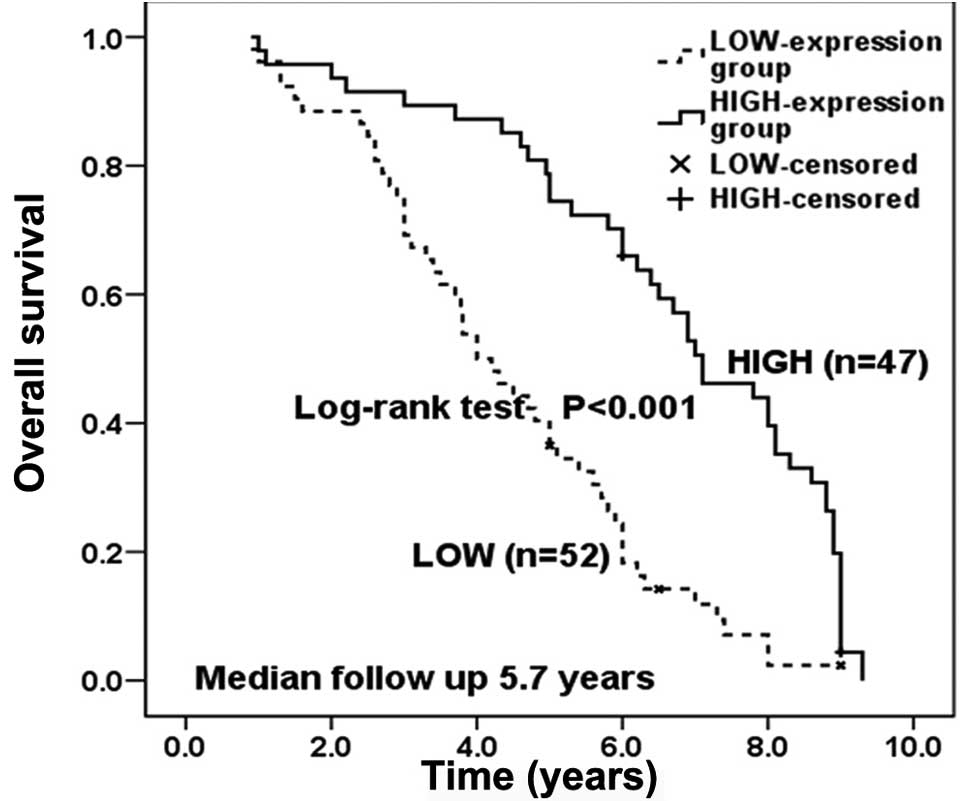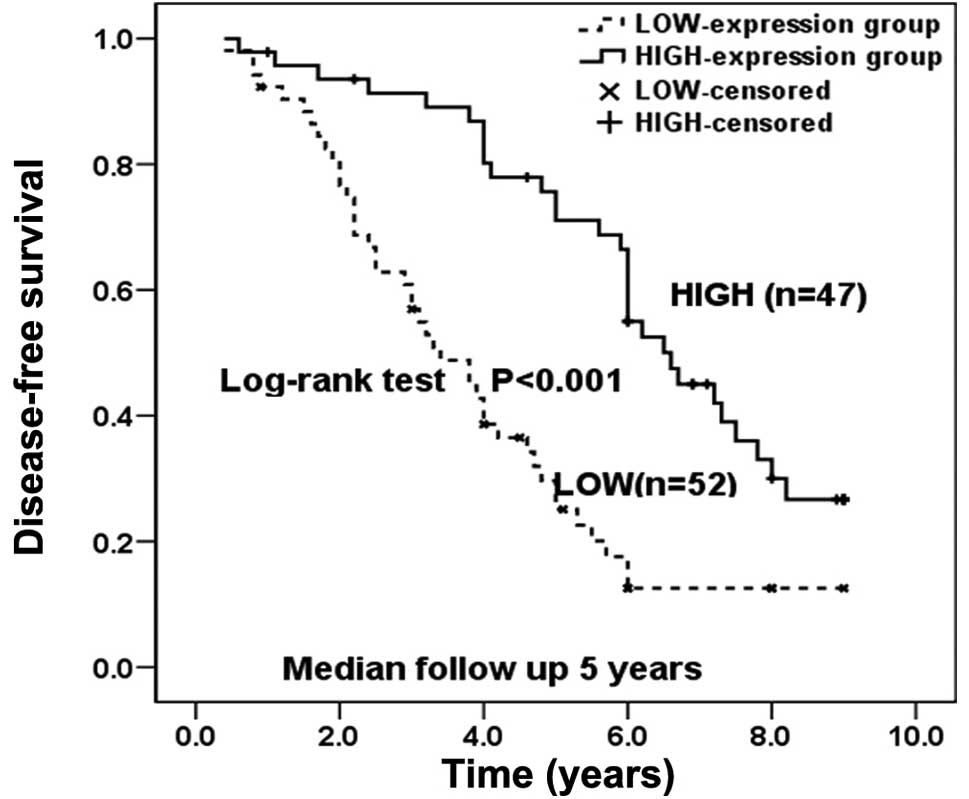|
1
|
Bosch FX, Ribes J, Cléries R and Díaz M:
Epidemiology of hepatocellular carcinoma. Clin Liver Dis.
9:191–211. 2005. View Article : Google Scholar : PubMed/NCBI
|
|
2
|
Yuen MF, Hou JL and Chutaputti A; Asia
Pacific Working Party on Prevention of Hepatocellular Carcinoma.
Hepatocellular carcinoma in the Asia pacific region. J
Gastroenterol Hepatol. 24:346–353. 2009. View Article : Google Scholar : PubMed/NCBI
|
|
3
|
El-Serag HB, Siegel AB, Davila JA, et al:
Treatment and outcomes of treating of hepatocellular carcinoma
among Medicare recipients in the United States: a population-based
study. J Hepatol. 44:158–166. 2006. View Article : Google Scholar : PubMed/NCBI
|
|
4
|
Yeh CN, Chen MF, Lee WC and Jeng LB:
Prognostic factors of hepatic resection for hepatocellular
carcinoma with cirrhosis: univariate and multivariate analysis. J
Surg Oncol. 81:195–202. 2002. View Article : Google Scholar : PubMed/NCBI
|
|
5
|
Nagasue N, Ono T, Yamanoi A, et al:
Prognostic factors and survival after hepatic resection for
hepatocellular carcinoma without cirrhosis. Br J Surg. 88:515–522.
2001. View Article : Google Scholar : PubMed/NCBI
|
|
6
|
Izumi N: Prediction and prevention of
intrahepatic recurrence of hepatocellular carcinoma. Hepatol Res.
42:226–232. 2012. View Article : Google Scholar : PubMed/NCBI
|
|
7
|
Susini C and Buscail L: Rationale for the
use of somatostatin analogs as antitumor agents. Ann Oncol.
17:1733–1742. 2006. View Article : Google Scholar : PubMed/NCBI
|
|
8
|
Reynaert H, Rombouts K, Vandermonde A, et
al: Expression of somatostatin receptors in normal and cirrhotic
human liver and in hepatocellular carcinoma. Gut. 53:1180–1189.
2004. View Article : Google Scholar : PubMed/NCBI
|
|
9
|
Bläker M, Schmitz M, Gocht A, et al:
Differential expression of somatostatin receptor subtypes in
hepatocellular carcinomas. J Hepatol. 41:112–118. 2004.PubMed/NCBI
|
|
10
|
Reubi JC, Zimmermann A, Jonas S, et al:
Regulatory peptide receptors in human hepatocellular carcinomas.
Gut. 45:766–774. 1999. View Article : Google Scholar : PubMed/NCBI
|
|
11
|
Dimitroulopoulos D, Xinopoulos D,
Tsamakidis K, et al: Long acting octreotide in the treatment of
advanced hepatocellular cancer and overexpression of somatostatin
receptors: randomized placebo-controlled trial. World J
Gastroenterol. 13:3164–3170. 2007.
|
|
12
|
Cebon J, Findlay M, Hargreaves C, et al;
Australasian Gastro-Intestinal Trials Group (AGITG) Ag0001H
Investigators. Somatostatin receptor expression, tumour response,
and quality of life in patients with advanced hepatocellular
carcinoma treated with long-acting octreotide. Br J Cancer.
95:853–861. 2006. View Article : Google Scholar
|
|
13
|
Borbath I and Horsmans Y: The results of a
randomized study on the use of long-acting octreotide in
hepatocellular carcinoma. Hepatology. 37:477–478. 2003.PubMed/NCBI
|
|
14
|
Kouroumalis E, Skordilis P, Thermos K,
Vasilaki A, Moschandrea J and Manousos ON: Treatment of
hepatocellular carcinoma with octreotide: a randomised controlled
study. Gut. 42:442–447. 1998. View Article : Google Scholar : PubMed/NCBI
|
|
15
|
Dimitroulopoulos D, Xinopoulos D,
Tsamakidis K, et al: The role of sandostatin LAR in treating
patients with advanced hepatocellular cancer.
Hepatogastroenterology. 49:1245–1250. 2002.PubMed/NCBI
|
|
16
|
Samonakis DN, Moschandreas J, Arnaoutis T,
et al: Treatment of hepatocellular carcinoma with long acting
somatostatin analogues. Oncol Rep. 9:903–907. 2002.PubMed/NCBI
|
|
17
|
Yuen MF, Poon RT, Lai CL, et al: A
randomized placebo-controlled study of long-acting octreotide for
the treatment of advanced hepatocellular carcinoma. Hepatology.
36:687–691. 2002. View Article : Google Scholar : PubMed/NCBI
|
|
18
|
Becker G, Allgaier HP, Olschewski M, et
al; HECTOR Study Group. Long-acting octreotide versus placebo for
treatment of advanced HCC: a randomized controlled double-blind
study. Hepatology. 45:9–15. 2007. View Article : Google Scholar : PubMed/NCBI
|
|
19
|
Barbare JC, Bouché O, Bonnetain F, et al:
Treatment of advanced hepatocellular carcinoma with long-acting
octreotide: a phase III multicentre, randomised, double blind
placebo-controlled study. Eur J Cancer. 45:1788–1797. 2009.
View Article : Google Scholar
|
|
20
|
Edmondson HA and Steiner PE: Primary
carcinoma of the liver: a study of 100 cases among 48,900
necropsies. Cancer. 7:462–503. 1954. View Article : Google Scholar : PubMed/NCBI
|
|
21
|
Sobin LH and Compton CC: TNM seventh
edition: what’s new, what’s changed: communication from the
International Union Against Cancer and the American Joint Committee
on Cancer. Cancer. 116:5336–5339. 2010.
|
|
22
|
Fasciani A, Quilici P, Biscaldi E, et al:
Overexpression and functional relevance of somatostatin receptor-1,
-2, and -5 in endometrium and endometriotic lesions. J Clin
Endocrinol Metab. 95:5315–5319. 2010. View Article : Google Scholar : PubMed/NCBI
|
|
23
|
Raulf F, Pérez J, Hoyer D and Bruns C:
Differential expression of five somatostatin receptor subtypes,
SSTR1–5, in the CNS and peripheral tissue. Digestion. 55(Suppl 3):
46–53. 1994.
|
|
24
|
Pawlikowski M and Melen-Mucha G:
Perspectives of new potential therapeutic applications of
somatostatin analogs. Neuro Endocrinol Lett. 24:21–27.
2003.PubMed/NCBI
|
|
25
|
Xie YM, Yan LN, Wei B, Guo MM and Tang CW:
Correlation of somatostatin receptor expression in human
hepatocellular carcinoma tissue to serum alpha-fetoprotein
concentration. Ai Zheng. 26:688–692. 2007.(In Chinese).
|
|
26
|
Li M, Li W, Kim HJ, Yao Q, Chen C and
Fisher WE: Characterization of somatostatin receptor expression in
human pancreatic cancer using real-time RT-PCR. J Surg Res.
119:130–137. 2004. View Article : Google Scholar : PubMed/NCBI
|
|
27
|
Jia WD, Xu GL, Wang W, et al: A
somatostatin analogue, octreotide, inhibits the occurrence of
second primary tumors and lung metastasis after resection of
hepatocellular carcinoma in mice. Tohoku J Exp Med. 218:155–160.
2009. View Article : Google Scholar
|
|
28
|
Papotti M, Bongiovanni M, Volante M, et
al: Expression of somatostatin receptor types 1–5 in 81 cases of
gastrointestinal and pancreatic endocrine tumors. A correlative
immunohistochemical and reverse-transcriptase polymerase chain
reaction analysis. Virchows Arch. 440:461–475. 2002.
|
|
29
|
Sestini R, Orlando C, Peri A, et al:
Quantitation of somatostatin receptor type 2 gene expression in
neuroblastoma cell lines and primary tumors using competitive
reverse transcription-polymerase chain reaction. Clin Cancer Res.
2:1757–1765. 1996.
|
|
30
|
Orlando C, Raggi CC, Bianchi S, et al:
Measurement of somatostatin receptor subtype 2 mRNA in breast
cancer and corresponding normal tissue. Endocr Relat Cancer.
11:323–332. 2004. View Article : Google Scholar : PubMed/NCBI
|
|
31
|
Buscail L, Saint-Laurent N, Chastre E, et
al: Loss of sst2 somatostatin receptor gene expression in human
pancreatic and colorectal cancer. Cancer Research. 56:1823–1827.
1996.PubMed/NCBI
|
|
32
|
Casini Raggi C, Calabrò A, Renzi D, et al:
Quantitative evaluation of somatostatin receptor subtype 2
expression in sporadic colorectal tumor and in the corresponding
normal mucosa. Clin Cancer Res. 8:419–427. 2002.PubMed/NCBI
|
|
33
|
Kumar M, Liu ZR, Thapa L and Qin RY:
Anti-angiogenic effects of somatostatin receptor subtype2 on human
pancreatic cancer xenografts. Carcinogenesis. 25:2075–2081. 2004.
View Article : Google Scholar : PubMed/NCBI
|
|
34
|
Zhou T, Xiao X, Xu B, Li H and Zou Y:
Overexpression of SSTR2 inhibited the growth of SSTR2-positive
tumors via multiple signaling pathways. Acta Oncol. 48:401–410.
2009. View Article : Google Scholar : PubMed/NCBI
|
|
35
|
Frasca F, Pandini G, Sciacca L, Pezzino V,
Squatrito S, Belfiore A and Vigneri R: The role of insulin
receptors and IGF-I receptors in cancer and other diseases. Arch
Physiol Biochem. 114:23–37. 2008. View Article : Google Scholar : PubMed/NCBI
|
|
36
|
Guillermet J, Saint-Laurent N, Rochaix P,
et al: Somatostatin receptor subtype 2 sensitizes human pancreatic
cancer cells to death ligand-induced apoptosis. Proc Natl Acad Sci
USA. 100:155–160. 2003. View Article : Google Scholar
|












